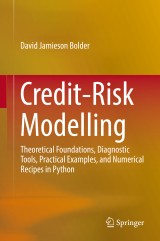Details

Credit-Risk Modelling
Theoretical Foundations, Diagnostic Tools, Practical Examples, and Numerical Recipes in Python|
CHF 77.00 |
|
| Verlag: | Springer |
| Format: | |
| Veröffentl.: | 31.10.2018 |
| ISBN/EAN: | 9783319946887 |
| Sprache: | englisch |
Dieses eBook enthält ein Wasserzeichen.
Beschreibungen
The risk of counterparty default in banking, insurance, institutional, and pension-fund portfolios is an area of ongoing and increasing importance for finance practitioners. It is, unfortunately, a topic with a high degree of technical complexity. Addressing this challenge, this book provides a comprehensive and attainable mathematical and statistical discussion of a broad range of existing default-risk models. Model description and derivation, however, is only part of the story. Through use of exhaustive practical examples and extensive code illustrations in the Python programming language, this work also explicitly shows the reader how these models are implemented. Bringing these complex approaches to life by combining the technical details with actual real-life Python code reduces the burden of model complexity and enhances accessibility to this decidedly specialized field of study. The entire work is also liberally supplemented with model-diagnostic, calibration, and parameter-estimation techniques to assist the quantitative analyst in day-to-day implementation as well as in mitigating model risk. Written by an active and experienced practitioner, it is an invaluable learning resource and reference text for financial-risk practitioners and an excellent source for advanced undergraduate and graduate students seeking to acquire knowledge of the key elements of this discipline.
<p>Getting Started.- Part I Modelling Frameworks.- A Natural First Step.-Mixture or Actuarial Models.- Threshold Models.-The Genesis of Credit-Risk Modelling.- Part II Diagnostic Tools.- A Regulatory Perspective.- Risk Attribution.- Monte Carlo Methods.- Part III Parameter Estimation.- Default Probabilities.- Default and Asset Correlation.</p>
<div><p>David Jamieson Bolder is currently head of the World Bank Group’s (WBG) model-risk function. Prior to this appointment, he provided analytic support to the Bank for International Settlements’ (BIS) treasury and asset-management functions and worked in quantitative roles at the Bank of Canada, the World Bank Treasury, and the European Bank for Reconstruction and Development. He has authored numerous papers, articles, and chapters in books on financial modelling, stochastic simulation, and optimization. He has also published a comprehensive book on fixed-income portfolio analytics. His career has focused on the application of mathematical techniques towards informing decision-making in the areas of sovereign-debt, pension-fund, portfolio-risk, and foreign-reserve management.</p></div><div><br></div><div><br></div><p></p>
The risk of counterparty default in banking, insurance, institutional, and pension-fund portfolios is an area of ongoing and increasing importance for finance practitioners. It is, unfortunately, a topic with a high degree of technical complexity. Addressing this challenge, this book provides a comprehensive and attainable mathematical and statistical discussion of a broad range of existing default-risk models. Model description and derivation, however, is only part of the story. Through use of exhaustive practical examples and extensive code illustrations in the Python programming language, this work also explicitly shows the reader how these models are implemented. Bringing these complex approaches to life by combining the technical details with actual real-life Python code reduces the burden of model complexity and enhances accessibility to this decidedly specialized field of study. The entire work is also liberally supplemented with model-diagnostic, calibration, and parameter-estimation techniques to assist the quantitative analyst in day-to-day implementation as well as in mitigating model risk. Written by an active and experienced practitioner, it is an invaluable learning resource and reference text for financial-risk practitioners and an excellent source for advanced undergraduate and graduate students seeking to acquire knowledge of the key elements of this discipline.
Demonstrates a broad range of state-of-the-art credit-risk models and underscores their interlinkages Includes extensive Python code to bring the models, diagnostic tools, and estimation of key inputs parameters to life Combination of mathematical foundations and practical Python code implementation enriches the reader’s understanding and competence in this important field
<p>Demonstrates a broad range of state-of-the-art credit-risk models and underscores their interlinkages</p> <p> </p> <p>Includes extensive Python code to bring the models, diagnostic tools, and estimation of key inputs parameters to life </p> <p> </p> <p>Combination of mathematical foundations and practical Python code implementation enriches the reader’s understanding and competence in this important field<b></b></p>
Diese Produkte könnten Sie auch interessieren:

Die Festlegung von Wesentlichkeitsgrenzen im Rahmen der Abschlussprüfung

von: Elina Valpetere

CHF 19.00
















